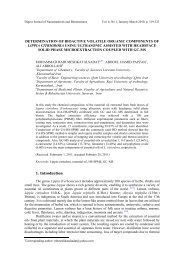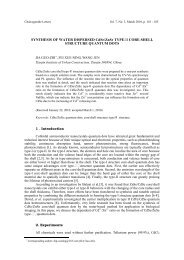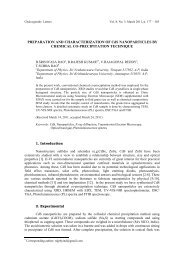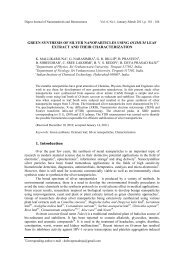Investigation of Properties of Tin Oxide Thin Film
Investigation of Properties of Tin Oxide Thin Film
Investigation of Properties of Tin Oxide Thin Film
Create successful ePaper yourself
Turn your PDF publications into a flip-book with our unique Google optimized e-Paper software.
Journal <strong>of</strong> Ovonic Research Vol. 5, No. 4, August 2009, p. 77 - 85<br />
OPTICAL AND GAS SENSING CHARACTERISTICS OF TIN OXIDE<br />
NANO-CRYSTALLINE THIN FILM<br />
R. L. MISHRA 1 , SHEO.K.MISHRA, S. G. PRAKASH<br />
Department <strong>of</strong> Electronics and Communication, University <strong>of</strong> Allahabad,<br />
Allahabad-211002, India<br />
Transparent conducting tin oxide (SnO2) thin film has been deposited on glass substrate by<br />
spray pyrolysis technique, taking starting material tin chloride solution (SnCl2.2H2O) and<br />
using ultrasonic nebulizer at substrate temperature 300±10 o C. The XRD result shows a<br />
regular, smooth morphology. The deposited film was found to be polycrystalline. The<br />
average grain size <strong>of</strong> SnO2 was found to be 48.6 nm as calculated by XRD using Debye<br />
Scherrer Formula .After annealing the film in air at 400 o C the grain size was 51.02 nm.<br />
The thickness <strong>of</strong> the deposited film was <strong>of</strong> the order <strong>of</strong> 500 nm. The optical absorption,<br />
transmittance, reflectance and optical conductivity have been measured. It was found that<br />
the average transmittance <strong>of</strong> the film is around 78 % at wavelength 550 nm. Finally the<br />
ethanol gas sensing properties <strong>of</strong> the film was also performed.<br />
(Received August 4, 2009; accepted august 16, 2009)<br />
Keywords: SnO2 thin film; Spray pyrolysis Technique; Surface morphology;<br />
Optical properties<br />
1. Introduction<br />
In the last decade, among the known oxide, tin oxide (SnO2) semiconducting film has been<br />
intensively used in the field <strong>of</strong> microelectronics and stable gas sensors, specifically in recognition<br />
<strong>of</strong> volatile organic compound (VOC). The film is highly transparent, chemically inert, and<br />
mechanically hard. Application <strong>of</strong> the tin oxide films are not limitted to the research laboratory but<br />
are used commercially in environmental monitoring , industrial electronic sensor , liquid crystal<br />
displays etc [1].Owing to its low resistivity and high transmittance, tin oxide thin films are as a<br />
window layer in solar cells [2] . The gas sensing properties <strong>of</strong> tin oxide thin films have been<br />
performed for different gases like CO, NOx, H2S, H2, CH4 and CNG etc. [3-5]. Doped or undoped<br />
tin oxide films can be deposited by several methods such as Thermal Evaporation [6-7], Chemical<br />
Vapor Deposition [8-9] R.F. Magnetron Co- sputtering [10-11], Laser Pulse Evaporation [12-13]<br />
and Spray Pyrolysis [14-15]. Among all technique spray pyrolysis has been used extensively<br />
beeing less expensive, large area deposition and chemically viable technique. It has been reported<br />
by different workers that the grain size can be easily controlled at the atomic level, and solution<br />
level [16-17]. Jagadish et al [18] studied the optical and electrical properties <strong>of</strong> spray deposited<br />
films . Concentration <strong>of</strong> the starting material (solution) highly affects the nature <strong>of</strong> the film mainly<br />
its grain size, growth <strong>of</strong> the film, gas sensing properties and optical characteristics [19,7]. The<br />
present analysis is focused on optimization, for depositing good tin oxide thin film by spray<br />
pyrolysis and to investigate structural, optical and gas sensing properties <strong>of</strong> SnO2 thin film at<br />
molar concentration 0.1M.
78<br />
2. Experimental details<br />
2.1 Deposition Method <strong>of</strong> SnO2 <strong>Thin</strong> <strong>Film</strong>:<br />
SnO2 thin film has been successfully deposited by spray pyrolysis. The film is deposited<br />
using tin chloride solution <strong>of</strong> concentration 0.1M mixed in tripled distilled water and 0.1ml<br />
methanol was added for every 5 ml <strong>of</strong> tin chloride solution .Methanol helps decomposition <strong>of</strong><br />
chloride solution and forms a SnO2 film on a heated substrate in air. The sprayed solution was<br />
deposited on the glass substrate that was carefully cleaned with dilute HCl and finally cleaned with<br />
acetone .The substrate temperature and spray rate was maintained at 300±10 o C and 0.5 ml/min<br />
respectively.<br />
2.2 Characterization <strong>of</strong> SnO2 <strong>Thin</strong> <strong>Film</strong><br />
The deposited SnO2 film is characterized by XRD measurement using SIEMENS<br />
diffraktometer model-D5000. The optical transmittance spectra <strong>of</strong> the deposited films were<br />
recorded in the wavelength range <strong>of</strong> 340 nm to 995 nm using VIS-IR spectrophotometer<br />
SHIMADZU model -1601. Finally, gas sensing properties have been performed using Vander<br />
Pauw technique via four-probe method. The contacts <strong>of</strong> the four probes were made by silver past<br />
and gas sensing properties have been preformed in a closed chamber <strong>of</strong> 1 liter capacity attached<br />
with temperature controller that controls the temperature <strong>of</strong> the heater surface. The thickness <strong>of</strong><br />
film was measured by Sloan Dektak 3D Surface Pr<strong>of</strong>ilometer.<br />
3. Result and discussion<br />
3.1 Structural and Micro-structural analysis <strong>of</strong> SnO2 <strong>Film</strong>:<br />
Structural analysis <strong>of</strong> the deposited SnO2 film was carried out by using CuKα radiation,<br />
source having wavelength 1.5406 Å. The X-ray diffraction pattern <strong>of</strong> the film is recorded. Figure.<br />
1(a), 1(b) shows the XRD patterns <strong>of</strong> spray deposited undoped tin oxide thin film which is<br />
crystalline in nature with well defined peaks that match standard interplanar spacing JCPDS card<br />
no. 05–0640 and (hkl) values are shown in Table 1.<br />
Table 1. (hkl) Value <strong>of</strong> XRD at 300 o C.<br />
2θ D value hkl<br />
26.8<br />
31.06<br />
33.99<br />
38.05<br />
52.08<br />
54.66<br />
61.52<br />
3.460<br />
3.325<br />
2.884<br />
2.637<br />
2.4510<br />
2.050<br />
1.426<br />
These Values were compared with the reported value [20]. The substrate temperature plays an<br />
important role in the film formation. When the substrate temperature is below 260 o C the spray<br />
falling on the substrate will under go in complete thermal decomposition giving foggy film whose<br />
transparency as well as electrical conductivity will be very poor. The substrate temperature is to<br />
high > 500 o C , the spray gets vaporized before reaching the substrate and the film becomes almost<br />
powder. Where the optimum substreat temperature in the range <strong>of</strong> 260 o C -500 o C the spray<br />
reaches the substrate surface in the semi-vapour state and complete oxidation takes place. To<br />
obtain more quantitative information, the XRD pattern was analyzed with Gaussian function where<br />
110<br />
101<br />
200<br />
111<br />
211<br />
220<br />
310
full width and half maxima [FWHM] was determined. The grain size <strong>of</strong> SnO2 thin film D; can be<br />
estimated by the Debye-Scherrer formula [10].<br />
D =<br />
Where, D = Crystalline grain size.<br />
β = FWHM <strong>of</strong> the observed peak.<br />
λ= wave length <strong>of</strong> the X-ray diffraction<br />
θ = Angle <strong>of</strong> diffraction<br />
0.9 λ<br />
β cos θ<br />
Using Scherrer Formula the average grain size <strong>of</strong> deposited film, is calculated as 48.6 nm<br />
.It is also observed that if the undoped film deposited 300 o C was annealed in air at 400 o C , the<br />
number <strong>of</strong> peaks increased but at the same time there was a sharp increase in resistance which may<br />
be due to further oxidation and also grain size increases to 51.02 nm. Figure.1 (b) Compare the<br />
result [21]<br />
Intensity (in arb. unit)<br />
Intensity (in arb. unit)<br />
500<br />
400<br />
300<br />
200<br />
100<br />
0<br />
(110)<br />
(101)<br />
(200)<br />
(111)<br />
(211)<br />
(220)<br />
(310)<br />
20 30 40 50 60 70<br />
Fig.. 1(a) XRD <strong>of</strong> SnO2 thin film deposited at temperature 300 o C<br />
500<br />
400<br />
300<br />
200<br />
100<br />
0<br />
(110)<br />
(101)<br />
(200)<br />
2 θ<br />
(111)<br />
(211)<br />
(220)<br />
(310)<br />
20 30 40 50 60 70<br />
Fig. 1(b) XRD <strong>of</strong> SnO2 thin film anneled at temperature 400 o C<br />
2 θ<br />
79<br />
(1)
80<br />
3.2 Optical Characterization <strong>of</strong> SnO2 <strong>Film</strong><br />
The optical transmittance spectra <strong>of</strong> the deposited film were recorded. The variation <strong>of</strong><br />
optical transmittance (%T) with wavelength λ <strong>of</strong> 0.1M <strong>of</strong> the spray deposited tin oxide film at<br />
substrate temperature 300 o C .It was found that the average transmittance <strong>of</strong> the film is 78%<br />
Figure 2 . The absorption coefficient can be calculated from the Lambert’s formula [22].<br />
Where, t = is a thickness <strong>of</strong> the film<br />
T= is a transmittance <strong>of</strong> the film.<br />
absorption<br />
0.6<br />
0.5<br />
0.4<br />
0.3<br />
0.2<br />
0.1<br />
0.0<br />
(αhν) 2 (eV/cm) 2<br />
α = (1/t) log (1/T)<br />
400 500 600<br />
20<br />
700<br />
Wavelangth (nm)<br />
Fig.2. Absorption and Transmission Spectrum <strong>of</strong> SnO2 thin film<br />
1.2x10 11<br />
1.0x10 11<br />
8.0x10 10<br />
6.0x10 10<br />
4.0x10 10<br />
2.0x10 10<br />
0.0<br />
Eg=3.71<br />
1 2 3 4<br />
hν (eV)<br />
Fig. 3. Toue Plot <strong>of</strong> (αҺυ) 2 with photon energy in SnO2 thin film<br />
90<br />
80<br />
70<br />
60<br />
50<br />
40<br />
30<br />
Transmitance %<br />
(2)
Fig. 3 shows the variation <strong>of</strong> (αhν ) 2 & (hν) for the determining the band gap Eg <strong>of</strong> SnO2<br />
film by extrapolation <strong>of</strong> curve . The incident photon energy is related to the direct band gap Eg by<br />
equation-<br />
(α hν) α (hν - Eg) 1\2 (3)<br />
The optical band gape was estimated in lower wave length region and it was found to be<br />
3.71 eV. The reflectance (R) has been found by using relation ship<br />
Reflactance in %<br />
80<br />
70<br />
60<br />
50<br />
40<br />
30<br />
20<br />
10<br />
R+T+A=1<br />
400 500 600 700<br />
Wavelength (nm)<br />
Fig. 4. Reflectance Spectra <strong>of</strong> SnO2 thin film<br />
As shown in Fig. 4.The refractive index (n) is calculated by the formula [23 ].<br />
( n- 1) + k<br />
R =<br />
( 1)<br />
2 2<br />
81<br />
2 2 (4)<br />
n+ + k<br />
The variation <strong>of</strong> optical conductivity (σ) with (hν) in Fig. 5 .The optical conductivity (σ)<br />
was determined using the formula<br />
αnc<br />
σ = (5)<br />
4 π
82<br />
Optical Condutivity (sec -1 )<br />
2.5x10 12<br />
2.0x10 12<br />
1.5x10 12<br />
1.0x10 12<br />
5.0x10 11<br />
0.0<br />
1 2 3 4<br />
hν (eV)<br />
Fig.5. Change in opetical conductivity <strong>of</strong> SnO2 thin film.<br />
3.3 Gas (Ethanol) Sensitivity <strong>of</strong> the SnO2 <strong>Film</strong><br />
The sensitivity <strong>of</strong> the film is calculated by the change in the surface resistance in presence<br />
<strong>of</strong> gas i.e. the ratio <strong>of</strong> surface resistance <strong>of</strong> the film in air (Ra) and in gas (Rg) represents the<br />
sensitivity. As the temperature increase the sufficiently decrease in the surface resistance have<br />
been observed. It had been reported that gas sensing mechanism <strong>of</strong> most oxide semiconductor gas<br />
sensors was based on the absorption <strong>of</strong> gas on the surface [24]. The reason <strong>of</strong> decrease in<br />
resistance is because the surface <strong>of</strong> SnO2 is covered with chemisorbed negative oxygen ion which<br />
could react with the β-H <strong>of</strong> C2H5OH and also found from differential thermal analysis (DTA) the<br />
endothermic weight loss due to sublimation and evaporation decrease the film resistance provide<br />
the optimum temperature range 260-380 o C , for sensitivity <strong>of</strong> SnO2 thin film . When SnO2 thin<br />
film is exposed to air , an oxygen ion molecule is absorbed onto the surface <strong>of</strong> SnO2 sensor to form<br />
O2 - or O - , ion by attracting an electron from conduction band <strong>of</strong> the SnO2 thin film as shown in<br />
equation, O2+ 2e = O2 2 - or 2O2 +1e = 2O2 - . So the high resistance <strong>of</strong> SnO2 thin film is present in<br />
air. For active ethanol gas at moderate temperature, the ethanol gas reacts with oxygen ion<br />
molecule on the surface and gives up electron as can be described by,<br />
2C2H5OH + O2 2- = 2CH3CHO + 2H2O + 2e. (6)<br />
2C2H5OH + O2 - = 2CH3CHO + 2H2O + 1e. (7)<br />
Thus, the electrons released from the surface reaction transfer back into the conduction<br />
band which increase the conductivity and lower resistance <strong>of</strong> SnO2 as shown in Figure 6. The<br />
effect <strong>of</strong> chemisorptions has been discussed in details by V. S. Vaishnav et al. [7]. The gas<br />
sensitivity <strong>of</strong> the deposited SnO2 thin film for ethanol gas also has been studied at concentration<br />
100 ppm. The plot shown in Figure.7 represents the variation in the sensitivity with temperature<br />
and maximum sensitivity at a temperature <strong>of</strong> 305 o C.
Resistance (in Kohm)<br />
Sensitivity<br />
800<br />
700<br />
600<br />
500<br />
400<br />
300<br />
200<br />
100<br />
120<br />
80<br />
40<br />
0<br />
SnO 2 thin film<br />
Rg - resistance <strong>of</strong> the film in Ethanol gas<br />
Ra - resistance <strong>of</strong> the film in Air<br />
220 240 260 280 300 320 340 360 380<br />
Temperature (in 0 C)<br />
Fig. 6. Change in resistance in Air and Ethanol atmosphere at 100 ppm<br />
Sensitivity <strong>of</strong> SnO 2 thin film<br />
220 240 260 280 300 320 340 360 380<br />
Temperature (in 0 C)<br />
Fig. 7. Variation <strong>of</strong> ethanol gas sensitivity with temperature<br />
50<br />
40<br />
30<br />
20<br />
10<br />
0<br />
Resistance (in Kohm)<br />
83
84<br />
Resistance (in Kohm)<br />
750<br />
700<br />
650<br />
600<br />
550<br />
500<br />
450<br />
400<br />
Injecting Ethanol gas<br />
SnO 2 thin film<br />
Variation in Resistance with time<br />
0 200 400 600 800 1000<br />
Time (in sec.)<br />
Fig. 8. Change in resistance <strong>of</strong> SnO2 thin film in ethanol (100 ppm) with time<br />
The variation <strong>of</strong> resistance with time show in Figure. 8. The rapid decrease in resistance<br />
has been observed in the time 170 sec. to 370 sec after injection <strong>of</strong> ethanol gas in chamber at 100<br />
ppm gas concentration. This result reveals that within 200 sec the resistance <strong>of</strong> the SnO2 thin film<br />
decreases 240 Kohm froms its normal value.<br />
4. Conclusions<br />
Transparent and conducting tin oxide film has been deposited by spray pyrolysis<br />
techniques. Structural, optical and gas sensing properties <strong>of</strong> the film studied as a function <strong>of</strong><br />
temperature. The average grain size <strong>of</strong> the film is 48.6 nm at 300 o c and 51.02 nm annealed 400 o C<br />
. The observed direct band gap Eg is 3.71 eV and average transmittance is 78 %. The ethanol gas<br />
sensitivity <strong>of</strong> SnO2 film is max. at 305 o C .<br />
References<br />
[1] G.W.Hunter, C. C.Liu, D.B.Makel, in: M.G.Hak (Ed), The MEMS Hand Book, CRC Press<br />
pp.1-22 ,(2002)<br />
[2] A.Goetzberger and C.Helbling Sol. Energy Mater and solar cells 62, 1 (2000).<br />
[3] R.S.Niranjan , and I.S. Mulla., Mater. Eng. B, 103, 103 (2003).<br />
[4] O.K.Varghase, L.K.Malhotra, Sensor & Actuators B 53, 19 (1998).<br />
[5] N.S. Baik, G.Sakai, N.Miura, N.Tamajoe, Sensor & Actuators B 63, 74 (2000).<br />
[6] E.Comini, G.Faglia, G.Sberveglieri, Z. Pon, Z.L.wang. Appl. Physics lett. 81 No-10, 1869<br />
(2002).<br />
[7] V.S.Vaishnav, P.D. Patel, N.G.Patel, <strong>Thin</strong> solid films 490, 94 (2005).<br />
[8] P.M.Gorley, V.V. Khomyak, S.V.Bilichuk, I.G.Orletsky, P.P. Hovly, V.O. Grechko, Mater,<br />
Sci. and Engg. B 118 ,160 (2005).<br />
[9] R.Mamazza Jr, D.L. Morel, C.S. Ferekider, <strong>Thin</strong> solid films 484 ,26 (2005).<br />
[10] J.Jeorg, S.Pyung CHOI. K.J. Hong, H.J. Song, J.S.Park. J.Korean Phys.Sco. 48, 960 (2006).
[11] K.S. Yoo, S.H. Park, J.H. Karg, Sensors and Actuators B, 180 ,159 (2005).<br />
[12] H.T. yang, Y.T.Cheung , J.Crystal Growth 56, 429 (1982).<br />
[13] F. Hui, T.M. Miller, R.M.Magruder, R.A.Weller, J.Appl.Phys. 91, 6194 (2002).<br />
[14] J.C. Mainfacier, J.P. Fillard, <strong>Thin</strong> solid films 77, 67 (1981).<br />
[15] V.Vasu, A. Subrahmanyama, <strong>Thin</strong> Solid films 202 , 283 (1991).<br />
[16] N.S. Baik, G.Sakai, N. Miura, N.Yamazoe, Sens. Actuators B 63, 74 (2000).<br />
[17] H.Yan, G.H. Chen, W.K.Man, S.P.wong, R.W.M. Kwok, <strong>Thin</strong> solid film 326, 88 (1998).<br />
[18] C.Jagadish, A.L. Dawar Sangay Sharma, P.K.Shishodia, K.N. Tripathi and P.C.Mathur<br />
Mater.Lett. 6, 149 (1988).<br />
[19] Z.Jic, H.Li- Hua, G.Shan, Z.Hui, Z.Jing-Gui, Sensors and Actuators B (Article in press)<br />
( 2005).<br />
[20] J. Melsheimer and B. Tesche <strong>Thin</strong> solid <strong>Film</strong>s 138 ,71 (1986).<br />
[21] D..M..Mukhamedrhina, N.B.Bei senkhanov, K.A.Mit, I.V. Valitova, V.A. Botvin, <strong>Thin</strong> solid<br />
film 495 ,316 (2006).<br />
[22] D.Sumangala, Devi Amma, V.K.Vaidyan, P.K.Manoj, Material Chemistry and Phys. 93 ,194<br />
(2005).<br />
[23] G. Hass, J.B.Heaey, W.R. Hunter in Physics <strong>of</strong> <strong>Thin</strong> films Ed. G. Hass, M.H. Francomble,<br />
J.L.Vassen, Academic Press, New York, 12, p. 1 (1982).<br />
[24] O.H.wan , Y.J.Li, T.H. Chen, X.L.Wang, J.P.He and C.L.Lin, Faberication and ethanol<br />
sensing Charactresics <strong>of</strong> ZnO Nanowier gas sensor , Appl. Phy. Lett. 84, 3654 (2004).<br />
85










